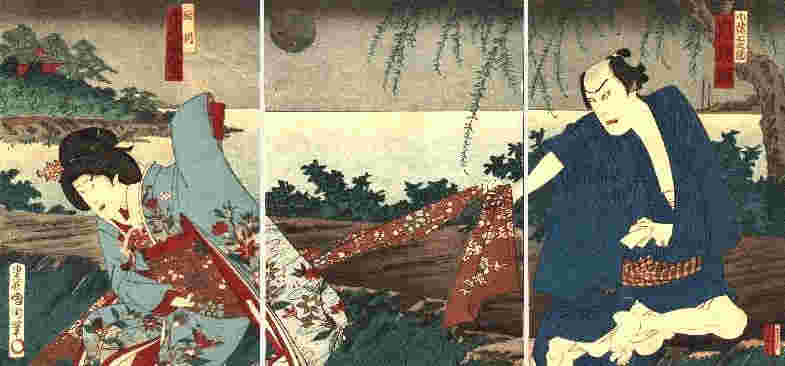




years, Japan had isolated itself
from the rest of the world - this
was the time of the Tokugawa Shogunate
(1615-1868), a military dictatorship of samurai,
headed up by the Tokugawa clan.
It was a
time of peace and prosperity and since
politics and government were the monopoly of
the samurai class, the only outlet for the
growing
merchant class ("chonin") was in the
economic
sector, making financial profits. As their wealth
grew, and it grew rapidly, the
chonin increased
their appetite for pleasure
and the
joys of this world ("ukiyo").
Haiku,
the kabuki theater, yoshiwara districts
(the "pleasure quarters") netsuke carvings,
and graphic arts of all sorts found willing
patrons and able practitioners.
Much of the
spirit of those times was depicted
with
great clarity in the woodblock prints of
Utamaro, Hokusai and Hiroshige. These
prints,
brought to the West by traders and ship
captains in the nineteenth century,
became
collector's items and had a marked effect on
the work of artists throughout
Europe.
 |
In
Tokugawa Japan, woodblock prints quickly
became "pop art", the art of the common
man.
Since the possibility of reproducing
many
copies from one set of carved blocks
enabled
prints to be sold cheaply, they were
thus
able to reach a wide
audience.

|
men, the original artist who makes the sketch,
the woodblock carver, and the printer who
applies each color to the blocks by hand.
The blocks necessary to produce a finished
print - one for each color used in addition to
the master block with the black outline - range
in number from four to a dozen or more.
 |
The art continues to develop and flourish with
new techniques and forms and collectors today
seek out the works of
Munakata, Murakami,
Saito and Nakayama among
others.
And now, on the following
pages, I would
like to offer a few
examples from my small
collection of
woodblock prints for your
inspection and enjoyment.

 ~NEXT~
~NEXT~